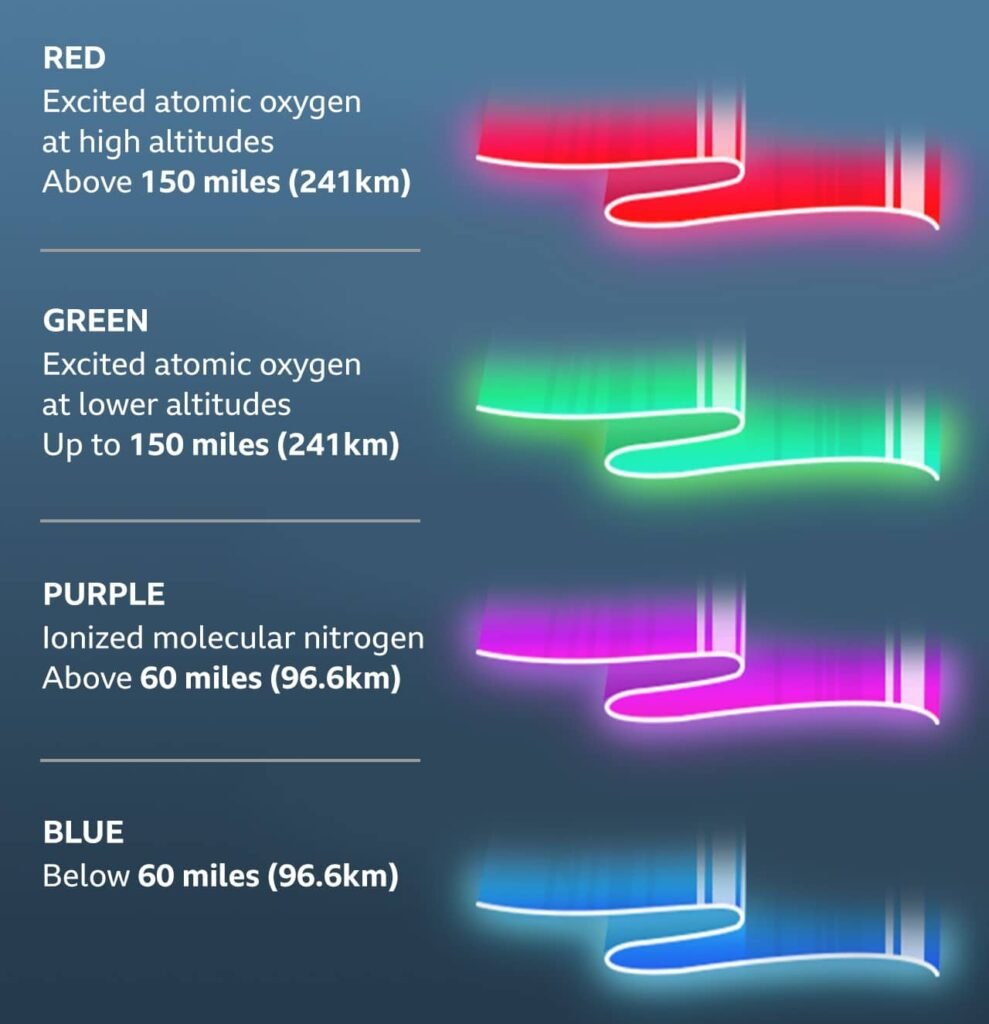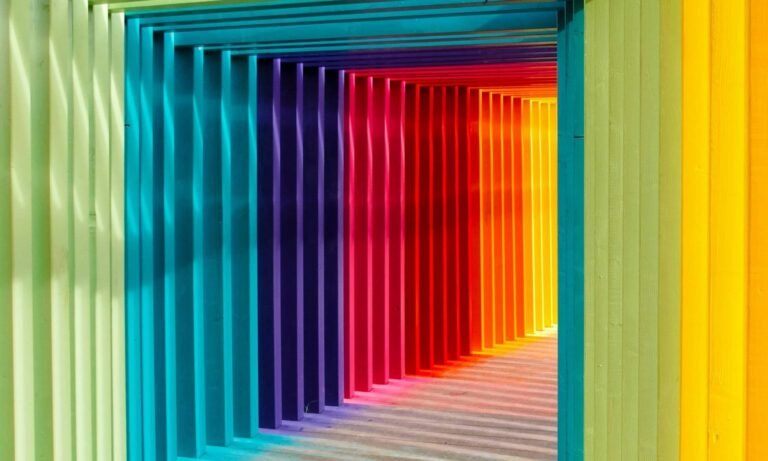
The Aurora Borealis, commonly referred to as the Northern Lights, is a captivating natural phenomenon that occurs primarily in high-latitude regions near the Arctic Circle. This mesmerizing light display results from the interaction between charged particles from the sun, known as solar wind, and Earth’s magnetic field and atmosphere. When solar wind reaches Earth, it carries a stream of electrons and protons that can sometimes become trapped by the planet’s magnetic forces.
As these charged particles travel along the magnetic field lines towards the polar regions, they collide with gas atoms in the Earth’s atmosphere, specifically oxygen and nitrogen. This collision releases energy in the form of light, leading to the visible spectral colors that constitute the Aurora Borealis. The varying colors – primarily green, pink, red, yellow, blue, and violet – arise from the types of gas involved in the reactions and their altitude. For instance, oxygen at higher altitudes emits red and purple hues, while lower altitudes generally produce the green light that is most commonly observed.
Cultural Significance
The Aurora Borealis, also known as the Northern Lights, has captivated human imagination for centuries and holds a prominent place in the cultural narratives of various indigenous and local communities. Different cultures have interpreted this mesmerizing phenomenon through their unique lenses, often embedding it into their folklore, rituals, and spiritual beliefs. For instance, among the Sámi people of Northern Europe, the lights are considered a manifestation of their ancestors. They believe that the souls of the departed communicate through the aurora, guiding the living with their wisdom.
In some Native American cultures, the aurora is seen as a bridge between the earthly realm and the spiritual world, often associated with the spirits of the ancestors watching over their descendants. The Inuit people of Canada have various legends surrounding the Northern Lights, perceiving them as the dances of souls or even as a symbol of a great hunt. The vibrant colors and movement of the aurora have not only sparked artistic inspiration but also fostered a sense of unity and continuity in storytelling traditions.
The artistic influence of the aurora extends globally, inspiring countless forms of visual art, music, and literature. Artists have attempted to capture the fabric of this natural spectacle in their works, portraying the ethereal beauty of the lights. Additionally, rituals centered around the aurora have been practiced in various cultures, often involving storytelling and communal gatherings to celebrate its arrival. These rituals serve to strengthen communal bonds and maintain a connection to ancestral beliefs, highlighting the profound impact of the Northern Lights on cultural identity.
Best Times and Places to Experience
The Aurora Borealis, commonly known as the Northern Lights, captivates many nature enthusiasts and travelers each year. To fully appreciate this spectacular natural phenomenon, it is crucial to know the optimal times and locations for viewing it. Generally, the best time to experience the Aurora Borealis is during the winter months, specifically from late September to early April. During this period, the nights are longer, providing ample darkness for better visibility. Moreover, the weather tends to be clearer in the winter, minimizing cloud cover that could obstruct the view.
Geographically, certain regions are renowned for their clear visibility of the Northern Lights. Locations such as Tromsø in Norway, Fairbanks in Alaska, and Yellowknife in Canada are often cited as prime spots. These areas lie under the Auroral Oval, where the likelihood of witnessing the lights increases markedly. In Europe, places like Abisko National Park in Sweden and the Lofoten Islands in Norway also offer excellent viewing opportunities, thanks to favorable weather conditions and accessibility.
- Tromsø is often referred to as the gateway to the Arctic and is one of the best places to see the Aurora Borealis. Nestled in the heart of the Norwegian fjords, this city boasts a long polar night during winter, providing ample opportunities for aurora sightings. With numerous tour options available, visitors can easily venture into the surrounding wilderness to experience the Northern Lights undisturbed.
- Fairbanks has gained a reputation for being one of the most reliable locations to view the Aurora Borealis in North America. Its geographical position offers clear skies and minimal light pollution, making it an ideal spot for aurora viewing. The best time to witness this phenomenon is during the winter months, where travelers can also enjoy various local winter activities.
- Yellowknife, situated in Canada’s Northwest Territories, offers some of the clearest skies for aurora enthusiasts. This destination features a long aurora season, extending from mid-autumn to early spring. With its unique landscape and welcoming community, Yellowknife is an excellent choice for those wishing to explore the beauty of the Northern Lights.
For photographers and travelers wishing to capture the beauty of the Aurora Borealis, preparation is key. Equipment should include a sturdy tripod, a camera capable of long exposure, and wide-angle lenses to frame the expansive night sky. In addition, selecting accommodations away from city lights can significantly enhance the visibility of the lights. Joining guided tours can also be beneficial, as experienced guides often know the best locations with optimal viewing conditions. Ultimately, planning ahead and being aware of local forecasts will greatly improve the chances of witnessing this stunning natural display.
Rare Variations
Notably, rare variations such as red, blue, and purple auroras, bring an extraordinary richness to the night sky. The appearance of these unusual colors is largely due to the altitude at which the auroras occur and the specific types of gases involved. For instance, red auroras can emerge when solar particles collide with oxygen at higher altitudes, leading to intense, vibrant displays. Meanwhile, blue hues are generally seen at lower altitudes, particularly associated with ions in the Earth’s atmosphere.
In addition to the fascinating colors, optical phenomena associated with auroras further enhance this ethereal experience. Auroral coronas and pillars are distinctive formations that occasionally accompany the more traditional auroral displays. Auroral coronas are characterized by the rays of light converging at a point directly overhead, creating a crown-like appearance. This specific effect can be influenced by the observer’s location and the geometry of the Earth’s magnetic field at that time. Pillars, on the other hand, manifest as column-shaped beams of light extending vertically through the sky. These formations result from the diffusion of solar energy through the atmosphere, leading to their striking visual impact.
Moreover, the underlying conditions for these rare variations stem from specific interactions within the Earth’s magnetic field and atmospheric composition. The intensity of solar activity directly affects the probability of witnessing these unusual displays. An increased solar wind, which brings forth higher concentrations of charged particles, often correlates with more vivid auroral phenomena, including those rare occurrences. Furthermore, the presence of specific pollutants or volcanic ash can enhance the array of colors, adding to the complexity and beauty of the aurora borealis experience.
“Then that’s what the Northern Lights are. All the lives that we’re not living.”
– Adi Alsaid
Conservation and Climate Change Impact
The Aurora Borealis, often considered one of nature’s most breathtaking spectacles, is increasingly at risk due to climate change and human activities. The delicate interplay between solar winds and the Earth’s magnetic field generates this stunning light show, but as global temperatures rise, the conditions necessary for seeing these brilliant displays may become less favorable. Climate change is causing shifts in weather patterns, which can directly influence the visibility of the Northern Lights. Specifically, increased cloud cover, altered precipitation patterns, and rising temperatures in polar regions may diminish the clear nights traditionally ideal for aurora viewing.
Furthermore, human activities contribute to overall climate change impacts. Urbanization, industrial emissions, and land use changes release greenhouse gases into the Atmosphere, exacerbating global warming. Such changes not only threaten the natural habitats of species that reside in areas known for auroral activity but also pose a risk to the indigenous cultures that have long celebrated the phenomenon as part of their heritage. Conservation efforts are essential to mitigate these impacts, emphasizing the need for sustainable practices that preserve both the environment and the cultural significance of the aurora.
Responsible tourism is another critical factor in the conservation of the Aurora Borealis. Tour operators and travelers alike must prioritize eco-friendly practices to minimize their carbon footprints when visiting popular viewing locations. Educating visitors about the importance of preserving the natural beauty and ecological integrity of these areas is vital. By promoting conservation strategies and raising awareness of how climate change affects the auroras, stakeholders can work together to protect this extraordinary natural wonder for future generations.
What’s More
The posts in My Blog feature reflective, story-driven pieces rooted in personal and societal insights.
The topics in My Interests explore abstract, philosophical ideas and their cultural and societal impact.
👁️ 5,740 Views

















